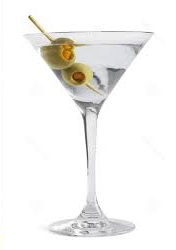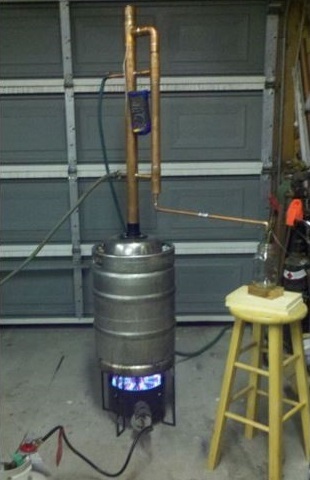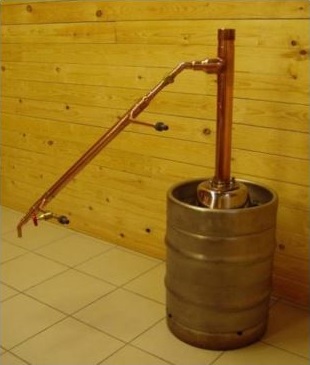Vodka Still Plans "Build-it-Yourself"
Vodka and Gin DistillationVodka Characteristics
 Vodka,
as a clear and nearly neutral spirit it has become the most popular
cocktail mixer for both men and women in North America.
Vodka,
as a clear and nearly neutral spirit it has become the most popular
cocktail mixer for both men and women in North America.
Vodka is a drink which originated in Eastern Europe.
In Russia, Poland and the Baltic countries, the lands of its origin, vodka is most often consumed straight up, served chilled in small glasses.
The name Vodka stems from the Russian word 'voda' meaning water or, as the Poles would say 'woda'.
Vodka's neutral and only slightly flavored characteristic makes it a great mixer with just about anything, and this the biggest reason for its popularity. In the United States, producing or infusing vodka with more intense flavors is on the rise. In the past, in Eastern Europe vodka was lightly flavored with grasses or herbal extracts.
The Main Ingredients Of Vodka Distillation
Vodka is made from mostly grains, corn, rye, wheat, and barley, and sometimes potatoes, beets or grapes. After fermentation of the sugars derived from the grains or potatoes, this “mash” is distilled at a very high proof, usually 190 (or 95% alcohol). This effectively eliminates most of its distinctive flavors which are more often present in other liquors that are distilled to lower proofs.
 The
1982 US Bureau of Alcohol, Tobacco and Firearms (BATF) regulations defined
vodka as a neutral spirit distilled or treated after distillation with
charcoal or other materials to render a final product without distinctive
character, aroma, taste or color. Vodka is generally taken to be odorless,
tasteless and colorless ethanol.
The
1982 US Bureau of Alcohol, Tobacco and Firearms (BATF) regulations defined
vodka as a neutral spirit distilled or treated after distillation with
charcoal or other materials to render a final product without distinctive
character, aroma, taste or color. Vodka is generally taken to be odorless,
tasteless and colorless ethanol.
The use of charcoal filtration is now optional, but carbon polishing and filtration methods are still a common practice. The quality of the finished product is determined, in large part, by the quality of the water, which makes up more than half of the vodka, the method of distillation including the number of distillations, the type of charcoal used in the purification process, and the equipment used.
What Type Of Still Is Best For Vodka Distillation?
Depending on your desired end result, several factors apply. In commercial production, reflux can produce the more neutral and consistent result that is typically desired. If your desire is for more flavor, then a pot still may be your best choice.
Valved Reflux, Internal Reflux, Bokakob Inline
 Valved
reflux is the preferred distillation method with regards to making Vodka.
While reflux will strip much of the flavors away, some will remain.
The main desire in vodka distillation is to produce the most neutral
and consistent product as possible.
Valved
reflux is the preferred distillation method with regards to making Vodka.
While reflux will strip much of the flavors away, some will remain.
The main desire in vodka distillation is to produce the most neutral
and consistent product as possible.
With that said, it can be challenging to get repeatable results from a valved reflux still if you get dynamic hydrometer bounce with just a minimal turn of either valve.
The type of reflux still offers some variables as well. A valved reflux tends to be more preferred than an internal reflux design, and the Bokakob inline a better choice than a valved reflux.
Then you have compound fractionating vapor management distillation. Choosing the type of condenser can be simple compared to the question of how to control reflux and withdraw the product.
There are three fundamental methods for accomplishing this:
- Liquid management: Divide, distribute liquid condensate directly
- Vapor management: Divide the vapor into two flows mechanically
- Cooling management: Divide vapor into two flows by managing the amount of cooling in the reflux condenser
For simplicity and budget wise choices, a good used sanke coupler type 15.5 gallon stainless steel keg can be the cats meow for affordable boilers. By using a tri clamp system you can attach a 2" column right to the top of the keg without the need for boring a hole in it.
Vodka Pot Still Distillation
 For
those looking to add a boost of flavor to their clear mind blowing potion,
a pot still may be the better choice over a reflux.
For
those looking to add a boost of flavor to their clear mind blowing potion,
a pot still may be the better choice over a reflux.
However, often rotgut vodkas are created using pot stills and multiple distillations.
Again, using a converted stainless steel beer keg boiler for a pot is a budget wise choice.
These beer kegs can often be found on craigslist for a decent price to start your distilling operation.
Fact is, there is often no need for a copper pot if you have copper tubes, and copper packing for heat transfer.

